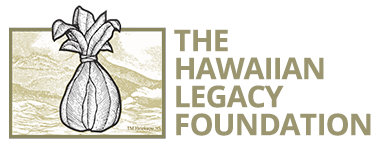About the songbook
The Eddie Kamae Songbook: A Musical Journey is a compilation of thirty-four songs that played an important role in Eddie’s life. Each song is presented in the form of a digital pūʻolo (bundle): researched lyrics and translations, a story about the song and its importance, video and audio clips, a music sheet and multiple resources that range from important to fascinating. The goal of this work is to tell Eddie and Myrna’s story of Eddie’s musical journey and share some of what he learned along the way.
Eddie and Myrna Kamae
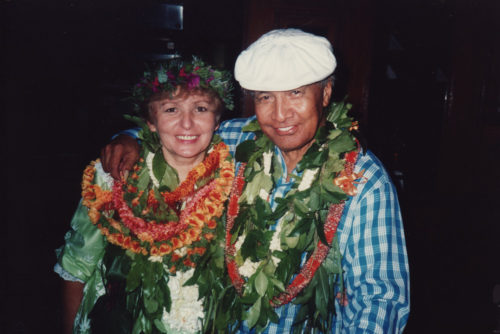
For over fifty years Eddie and his wife, Myrna, were responsible for fifteen albums of genre-defining Hawaiian music, ten award-winning documentaries, and curriculum for K-12 learners. While Eddie created the music, lead the Sons of Hawaiʻi, collected stories from kūpuna, and directed the documentaries, Myrna handled the business side of things, co-produced most of their projects and co-wrote several songs with Eddie. From the beginning, Myrna was a formidable notetaker and meticulously documented their work. Together they created the Hawaiian Legacy Foundation to document, preserve and perpetuate the cultural heritage of Hawaiʻi. Its archive consists of the raw footage from all documentaries, audio recordings, thousands of photographs, and papers ranging from original lyrics, scores, arrangements, notebooks, correspondence, and scribbled ideas on cocktail napkins.
This project
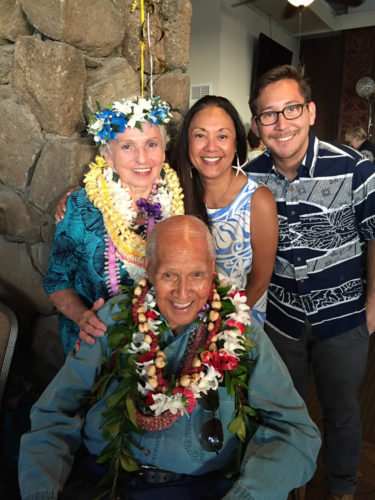
The seed for this project was planted when U.H. West Oʻahu chancellor Maenette K.P. Ah Nee-Benham talked with Myrna and found out she was busy pulling some of Eddie’s songs to share with musicians. Maenette suggested a songbook and the curriculum to go with it. The majority of the work was done by the Hui Hana, the core project team comprised of Myrna, archivist Kapena Shim, and language and curriculum specialist Lilinoe Andrews. They divvied up the work then huddled together every week in person or on Zoom for two years to ensure, as Maenette promised Eddie days before his death in 2017, that his work would be made available to students in Hawaiʻi’s classrooms.
Kapena began processing the Hawaiian Legacy Foundation archives in 2013. In 2015 digitization began on the ten documentaries, undertaken by ʻUluʻulu: The Henry Kuʻualoha Giugni Moving Image Archive of Hawaiʻi located at U.H. West Oʻahu. In June, 2018, Hui Hana started tackling the material for this collection with Myrna providing guidance, detail, accuracy, and alignment with the goals of the Hawaiian Legacy Foundation. Kapena served as project director and Lilinoe served as researcher and writer and updated the translations for all songs except for “Kalaupapa,” “Kanaka Waiolina,” “Kēlā Mea Whiffa,” “Nānā Mai,” and “Aloha Chant” which was worked on collectively by the group. Together the trio reviewed story drafts, lyrics, translations, original documents, and new research. The last six months were spent editing, rewriting, having the songs scored and thinking about the educational implications of each song.
Resources

The result is a songbook grounded in the rich resources of the Hawaiian Legacy Foundation archive and Hui Hana’s research. The primary sources were conversations and correspondence with Myrna and the materials from the HLF archive. Hui Hana relied heavily on James Houston’s biography of Eddie, Hawaiian Son: The Life and Music of Eddie Kamae, and the ten documentaries as secondary resources. They allowed the team to hear Eddie voice his thoughts about his teachers, the many songs in the songbook, and what he learned about Hawaiian music and life. Extensive use of published resources including Hawaiian and English language archives of Hawaiʻi’s newspapers added important information to the background stories of many of the songs. Additionally, the extensive cross-referencing of newspaper archives, online search engines and databases, and Hui Hana’s network sometimes yielded new or updated information that occasionally shed new light on previously published stories.
Original lyrics, translations, orthography, and notes
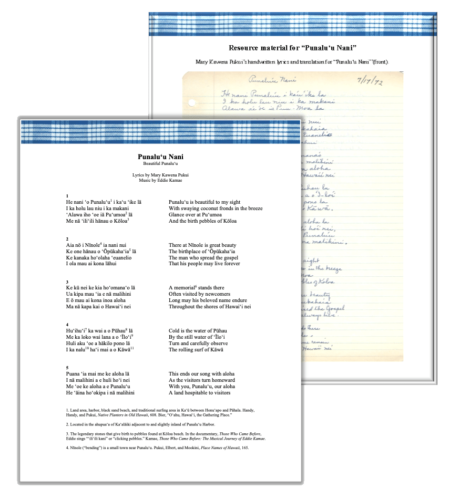
What is the right or correct version of a song? It is the prerogative of a composer to create different versions of their lyrics or scores let alone make changes during subsequent performances of them to reflect particular contexts, audiences, or times. One of the most challenging tasks was presenting a standard set of lyrics for each song based on the original lyrics and sometimes several slight variations thereof. Careful effort was made to note where the standard lyrics deviated from what Eddie sang in the accompanying audio sample.
English translations were done as narrowly as possible with attention to specifics and nuance while avoiding clumsy word-for-word explanations. Broad translations that make for pretty phrases in English were avoided to keep the emphasis on the integrity of the Hawaiian lyrics. All Hawaiian words (with the exception of personal names where exact spellings were unknown) were spelled according to modern orthography using diacritical marks.
Footnotes include short-form citations of sources and point the reader to important additional information that did not quite fit in the main body of the text. Full citations are included in the bibliographies.
Our hope
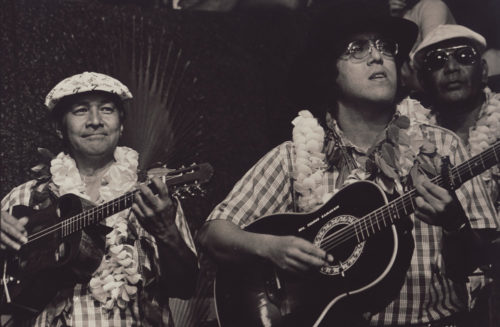
Hui Hana shares this work with a deep desire to perpetuate the knowledge Eddie gained from kūpuna of his time. This is what his teachers urged him to do. It is hoped that by exploring these songs, some of their lessons, stories, kaona (hidden poetic meaning), and aloha will resonate with you. We also hope that by playing and singing them you will not only help this music live on but reflect on your own stories and tell them. For educators, this publication serves as a foundation to create curriculum across multiple disciplines.
While the greatest effort was made to create an accurate publication that honors Eddie and Myrna’s stories, any shortcomings, mistakes or omissions that may appear are ours alone.
